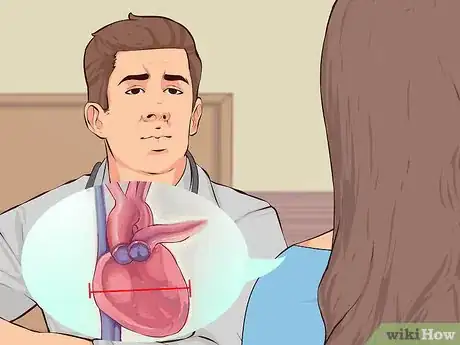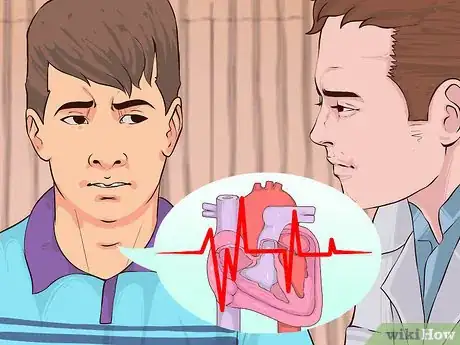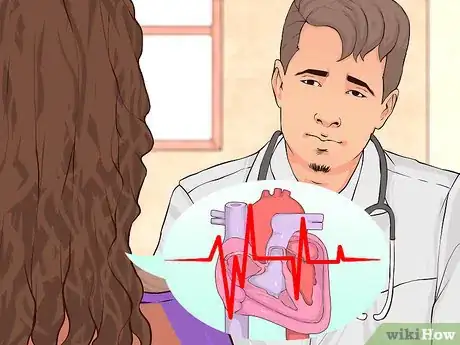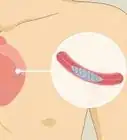This article was medically reviewed by Dale K. Mueller, MD. Dr. Mueller is a Cardiothoracic Surgeon with the Cardiothoracic & Vascular Surgical Associates group in Jacksonville, Florida. Dr. Mueller has over 25 years of experience as a surgeon and he completed his fellowship at Rush-Presbyterian-St. Luke's Medical Center in 1999. Dr. Mueller is a member of the Society of Thoracic Surgeons, Cook County Alumni Association, and Rush Surgical Society. He is board certified by the American Board of Surgeons.
There are 7 references cited in this article, which can be found at the bottom of the page.
This article has been viewed 255,780 times.
An echocardiogram enables the doctor to generate images of your heart in real-time using ultrasound. Ultrasound, or sounds higher than we can hear, are projected through your body and a machine reads the sound waves that are bounced back, and converts them to an image. It is not harmful to you. This is valuable for diagnosing several heart conditions, planning treatments, and the effectiveness of treatments. Many patients find it useful to understand the images and what the doctor is looking for.[1]
Steps
Interpreting the Results
-
1Ask your doctor how big your heart is. If your heart is enlarged or the walls of your heart have become thicker, this can be in indication of several problems. For example, the doctor will likely measure the thickness of the wall of the left ventricle (the major pumping chamber of the heart). If it is thicker than 1.5 cm, this is considered abnormal. This or other thickened heart walls could indicate several problems including:[2]
- High blood pressure
- Weak heart valves
- Damaged valves
-
2Determine the strength with which your heart pumps. These measures can indicate whether your heart is pumping enough blood to supply your body with the oxygen it needs. If not, you are at risk for heart failure. There are two measurements the doctor may discuss with you:[3]
- Left ventricular ejection fraction. This is the percentage of blood that is expelled from the heart during a heartbeat. A left ventricular ejection fraction of 60% is considered normal.
- Cardiac output. This is the volume of blood that the heart pumps per minute. At rest the average adult's heart pumps 4.8 to 6.4 liters of blood per minute.
Advertisement -
3Observe the pumping action of the heart. If parts of the wall of the heart are not pumping strongly, this can help the doctor pinpoint areas that have been damaged. This can occur due to tissue damage from a prior heart attack or coronary artery disease. Your doctor will be looking for several things:[4]
- Hyperkinesis. This occurs when the heart or parts of the walls of the heart contract too much.
- Hypokinesis. This occurs when the contractions are too weak.
- Akinesis. This occurs when the tissue does not contract.
- Dyskinesis. This occurs when the wall of the heart bulges out when it should be contracting.
-
4Examine the valves of your heart. You will likely be able to see the valves as gray lines that open and close with each beat of the heart enabling blood to pass between the chambers. Possible problems that you may see could be:[5]
- A valve does not close tightly and it lets blood flow backwards through it.
- A valve does not open all the way so it restricts blood flow.
-
5Look for heart defects. You may be able to observe structural problems such as:[6]
- Openings between chambers that should not be there
- Passages between the heart and blood vessels
- Heart defects that are developing a fetus
Understanding Echocardiograms
-
1Ask your doctor why you need an echocardiogram. An echocardiogram can help diagnose several conditions. Your doctor may perform an echocardiogram if they think you may have:[7]
- Heart murmurs
- Heart valve problems
- Atrial fibrillation
- An infection of the valves
- Fluid around the heart
- Blood clots
- Thickening of the walls of the heart
- Congenital heart disease
- High blood pressure in your lungs (pulmonary hypertension)
-
2Ask your doctor what type of echocardiogram you will have. There are several types of echocardiograms and the doctor will choose which one to do based on what information they want to have.[8]
- A transthoracic echocardiogram. This is a noninvasive procedure that does not hurt. The doctor puts gel on your chest and then moves a handheld machine called a transducer against your chest. The transducer projects ultrasound through your body. A computer reads the sound waves and produces pictures. This test can detect valve problems and enable the doctor to examine the thickness of the walls of the heart.
- A transesophageal echocardiogram. During this test, the doctor will put a tube with a transducer on it down your throat. This lets the doctor get pictures from a different angle than the transthoracic echocardiogram. You will get medication to help you relax and numb your throat.
- A stress echocardiogram. During this test, the ultrasound images will be produced while you exercise on a treadmill, ride a stationary bike, or receive medication to make your heart beat faster. This test can find problems that happen when your heart is under stress including conditions where your heart does not receive enough blood.
-
3Watch the monitor to determine what techniques the doctor uses. There are several different techniques the doctor may use. They enable the doctor to make different measurements.[9]
- M-Mode. This technique generates a outlines showing the heart's size, the chambers, and the thickness of the walls of the heart.
- A doppler echocardiogram. During this test, the machine measures the sound waves that are reflected off of the cells in your blood and uses this information to determine how your blood is flowing through your heart. The doctor can measure how fast the blood is flowing through your heart and in what direction it is traveling. This is useful for determining whether your heart is pumping enough blood and if you have any valve problems.
- Color doppler. During this method the computer highlights areas where the blood is flowing in a particular direction. This is helpful for detecting blood that is not flowing the correct direction.
- Two-dimensional echocardiography. This method produces a two-dimensional image of the heart as it beats. This is used to investigate the structures and valves of the heart.
- Three-dimensional echocardiography. This produces a much more detailed image which has depth instead of just length and width. It is often used to plan treatments.
Expert Q&A
Did you know you can get expert answers for this article?
Unlock expert answers by supporting wikiHow
-
QuestionWhat does yellow mean?
 Dale K. Mueller, MDDr. Mueller is a Cardiothoracic Surgeon with the Cardiothoracic & Vascular Surgical Associates group in Jacksonville, Florida. Dr. Mueller has over 25 years of experience as a surgeon and he completed his fellowship at Rush-Presbyterian-St. Luke's Medical Center in 1999. Dr. Mueller is a member of the Society of Thoracic Surgeons, Cook County Alumni Association, and Rush Surgical Society. He is board certified by the American Board of Surgeons.
Dale K. Mueller, MDDr. Mueller is a Cardiothoracic Surgeon with the Cardiothoracic & Vascular Surgical Associates group in Jacksonville, Florida. Dr. Mueller has over 25 years of experience as a surgeon and he completed his fellowship at Rush-Presbyterian-St. Luke's Medical Center in 1999. Dr. Mueller is a member of the Society of Thoracic Surgeons, Cook County Alumni Association, and Rush Surgical Society. He is board certified by the American Board of Surgeons.
Board Certified Cardiothoracic Surgeon
-
QuestionWhat is 30% indicative of?
 Dale K. Mueller, MDDr. Mueller is a Cardiothoracic Surgeon with the Cardiothoracic & Vascular Surgical Associates group in Jacksonville, Florida. Dr. Mueller has over 25 years of experience as a surgeon and he completed his fellowship at Rush-Presbyterian-St. Luke's Medical Center in 1999. Dr. Mueller is a member of the Society of Thoracic Surgeons, Cook County Alumni Association, and Rush Surgical Society. He is board certified by the American Board of Surgeons.
Dale K. Mueller, MDDr. Mueller is a Cardiothoracic Surgeon with the Cardiothoracic & Vascular Surgical Associates group in Jacksonville, Florida. Dr. Mueller has over 25 years of experience as a surgeon and he completed his fellowship at Rush-Presbyterian-St. Luke's Medical Center in 1999. Dr. Mueller is a member of the Society of Thoracic Surgeons, Cook County Alumni Association, and Rush Surgical Society. He is board certified by the American Board of Surgeons.
Board Certified Cardiothoracic Surgeon
-
QuestionHow to increase the E.F. when it is 30?
 Dale K. Mueller, MDDr. Mueller is a Cardiothoracic Surgeon with the Cardiothoracic & Vascular Surgical Associates group in Jacksonville, Florida. Dr. Mueller has over 25 years of experience as a surgeon and he completed his fellowship at Rush-Presbyterian-St. Luke's Medical Center in 1999. Dr. Mueller is a member of the Society of Thoracic Surgeons, Cook County Alumni Association, and Rush Surgical Society. He is board certified by the American Board of Surgeons.
Dale K. Mueller, MDDr. Mueller is a Cardiothoracic Surgeon with the Cardiothoracic & Vascular Surgical Associates group in Jacksonville, Florida. Dr. Mueller has over 25 years of experience as a surgeon and he completed his fellowship at Rush-Presbyterian-St. Luke's Medical Center in 1999. Dr. Mueller is a member of the Society of Thoracic Surgeons, Cook County Alumni Association, and Rush Surgical Society. He is board certified by the American Board of Surgeons.
Board Certified Cardiothoracic Surgeon
References
- ↑ https://www.ncbi.nlm.nih.gov/books/NBK2215/
- ↑ https://www.heart.org/en/health-topics/heart-attack/diagnosing-a-heart-attack/echocardiogram-echo
- ↑ https://my.clevelandclinic.org/health/diagnostics/16947-echocardiogram
- ↑ https://patient.info/doctor/echocardiography
- ↑ https://www.hopkinsmedicine.org/health/treatment-tests-and-therapies/echocardiogram
- ↑ https://www.hopkinsmedicine.org/health/treatment-tests-and-therapies/echocardiogram
- ↑ https://medlineplus.gov/ency/article/003869.htm
- ↑ https://www.nhs.uk/conditions/echocardiogram/
- ↑ https://www.hopkinsmedicine.org/health/treatment-tests-and-therapies/echocardiogram
About This Article
To interpret an echocardiogram, talk to your doctor about how large your heart appears in it since an enlarged heart can be a sign of several problems, like high blood pressure and weak heart valves. Also, ask your doctor about your cardiac output and left ventricular ejection fraction, which are 2 measurements that indicate how strong your heart is. You can also examine the valves of your heart with your doctor to make sure they're opening and closing properly. For more tips from our Medical co-author, like how to distinguish between different types of echocardiograms, scroll down!







































































Medical Disclaimer
The content of this article is not intended to be a substitute for professional medical advice, examination, diagnosis, or treatment. You should always contact your doctor or other qualified healthcare professional before starting, changing, or stopping any kind of health treatment.
Read More...